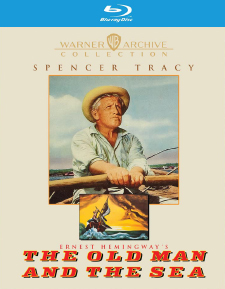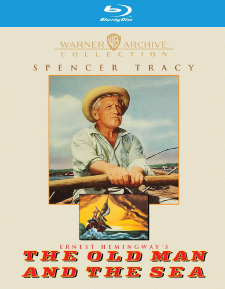Old Man and the Sea, The (Blu-ray Review)

Director
Fred Zinnemann, John SturgesRelease Date(s)
1958 (June 27, 2023)Studio(s)
Warner Bros. (Warner Archive Collection)- Film/Program Grade: C+
- Video Grade: A-
- Audio Grade: A-
- Extras Grade: C
Review
Nearly a one-man show for star Spencer Tracy, The Old Man and the Sea (1958) was a notoriously troubled adaptation of Ernest Hemingway’s debatably unfilmable 1952 novella. How notorious? Chew on this: David Lean’s 161-minute war epic The Bridge on the River Kwai, made the year before, was shot on location in Ceylon (now Sri Lanka), features three major stars, dozens of speaking parts, plenty of big-scale action scenes (including the blowing up of the title bridge with a vintage locomotive on top of it), and cost $2.8 million to make.
Other than a handful of extras and a child actor in a supporting part, The Old Man and the Sea is 86 minutes—a bit more than half as long as Kwai—of Tracy in a skiff or a one-room shack or café nearby, with maybe one-third of the footage shot on location in Cuba. Incredibly, that film cost $5 million, nearly twice Kwai’s budget. Even the logistically similar but far bigger-scale Moby Dick (1956) cost less, at $4.5 million. I’d wager that in 1958 one could have given Roger Corman 1% of Old Man’s final cost and he would have been able to come up with something almost as good.
Though made with an almost grave sincerity, the final result is painfully mediocre. Despite little flashes of exceptional filmmaking here and there, this Old Man and the Sea fails spectacularly in just about every way. Because it tries so hard and is, obviously, a prestigious production, reviewers tend to find little avenues of praise while acknowledging its innate wrong-headedness. In truth, almost nothing works.
The unnamed Old Man (he’s Santiago in Hemingway’s story) is a washed-up Cuban fisherman who has gone 84 days without a catch. The younger fishermen laugh at the old man, but 12-year-old protégé Manolin (Felipe Pazos, Jr.) loves him, and insists the Old Man’s luck will soon change.
On the 85th day, the Old Man sets out and finally hooks an enormous marlin, larger even than his modest skiff. His battle with the fish takes several days and nights, exhausting the Old Man to the point of mental and physical collapse. He’s also so far out to sea that bringing the big fish into port presents its own challenges; it’s too big to bring into the boat, and tying it alongside risks drawing hungry sharks.
Tracy is miscast, though that’s only one problem of many. In fairness, Santiago is not a native Cuban but a Spaniard from the Canary Islands, and explicitly blue-eyed, as mentioned in the film. Tracy, however, was also undeniably fair-skinned, lacking the muscles of such fishermen, and, at this point, a very overweight Irish-American. He promised to lose weight but didn’t, which works against scenes where Manolin is concerned the Old Man, too proud to admit it, is starving himself to death.
Tracy plays the Old Man with the slightest of accents, a welcome departure from his insufferable Portuguese fisherman in Captains Courageous (1937). However, Tracy’s Old Man has far less dialogue than Tracy’s unaccented, third-party narrator. Many have praised Tracy’s performance in this capacity, but for me it’s the film’s single biggest disappointment. A few years later Tracy narrated, wonderfully well, like a great storyteller, the Cinerama epic How the West Was Won (1962). But for Old Man Tracy sounds like he can’t wait to get it over and done with, like a high schooler asked to stand up and read Hemingway to the rest of his class. In order to convince Tracy to record the narration at all, the filmmakers hired actor Joseph Cotten to record the entire track first, partly to demonstrate its effectiveness to Tracy but also knowing Tracy’s ego would never permit using it. I wish Cotten’s track had survived; I wouldn’t be surprised if it were far superior.
The film began shooting with Fred Zinnemann directing. Just about everything that could go wrong did. Alcoholic Tracy arrived drunk and was so cantankerous and uncooperative toward everyone on the crew they grew to hate him. Hemingway thought Tracy too fat to be believed, quarreled with Tracy and refused to call the great actor by name. No one was satisfied with Pazos’s performance—at one point the narrator tells us Manolin bursts into tears while Pazos clearly remains dry-eyed—and there were several unsuccessful attempts to replace him, including footage shot with another child actor that was abandoned. The first robot marlin looked ridiculously unreal and sank without a trace the first time they tried using it. Zinnemann and cinematographer James Wong Howe worked too slowly for everyone’s taste and, after several months in Cuba, Zinnemann quit when the plug was pulled.
John Sturges replaced him, and most of the remaining fishing scenes were filmed in a studio tank at the studio. The finished film is thus a patchwork of location scenes, obvious studio tank footage with painted “skies,” and extensive process shots, reportedly one of the first in Hollywood using the blue-screen traveling matte process. John Huston’s Moby Dick likewise jumbles real locations, matte shots, and miniature special effects, and while the effect is heavily stylized and not photo-realistic in the usual sense, suspension of disbelief is easy and the picture is quite exciting and even mesmerizing. In Old Man, the film is merely a jumble of mismatched visuals and simply not believable or compelling on any level. The marlin prop looks like something one would find in a Three Stooges comedy. Even Sturges admitted later it was “technically the sloppiest picture I have ever made.”
There are some gorgeous individual shots by Howe of the fishing village, and of the various fishermen setting out or returning at night, but even these little pictorial nuggets are undermined by the jarring intercutting with all the process work.
Oddly, the one good scene in the picture, apparently directed by Zinnemann, is a flashback to the Old Man’s long-ago triumph, a two-day arm-wrestling bout with a “Negro” (Don Blackman) in Casablanca. As photographed by Howe the effect is startling—Tracy convincingly looks 20 years younger, the combination of makeup, lighting, and camera angles pulling off the effect. Tracy is also unusually good here.
Old Man never quite resolves another central conflict, of on one hand being a very unconventional Hollywood studio film while also trying to earn back an expense only a wealthy Hollywood studio could have afforded in the first place. This is especially apparent in Dimitri Tiomkin’s musical score, another aspect critics typically single out for praise. To my ears, though, it’s far too conventional and there’s way too much of it. Rather than using music sparingly to enhance critical scenes, Tiomkin’s score is pretty much wall-to-wall, cueing the audience how to feel.
For decades, The Old Man and the Sea looked terrible on broadcast television; so grainy and ugly were TV prints, I wrongly assumed it was panned-and-scanned from CinemaScope when, in fact, it was shot for standard 1.85:1 widescreen. Warner Archive’s new Blu-ray (from a 4K scan) helps a lot insofar as individual James Wong Howe shots now look gorgeous, but the fine transfer can’t hide the ugly process work, and the added clarity only makes the studio tank (and especially the rubber marlin) appear even more unreal. The DTS-HD Master Audio (2.0 mono) is fine, and supported by optional English subtitles.
The minimal extras include an old featurette, Hemingway: The Legend and the Sea (3 minutes), which is mostly home movie footage of Hemingway shot for an abandoned documentary; and a trailer (1:43) that includes no footage from the film, but rather a storybook-type series of drawings.
The existential core of The Old Man and the Sea is lost amid the patchwork filmmaking, the phoniness of most of the fishing scenes, Tracy’s disappointing performance as the Old Man and his perfunctory narration, and Dimitri Tiomkin’s overwrought score. It’s such an ambitious work with so much great talent attached to it that it’s worth seeing once but once will be more than enough.
- Stuart Galbraith IV

